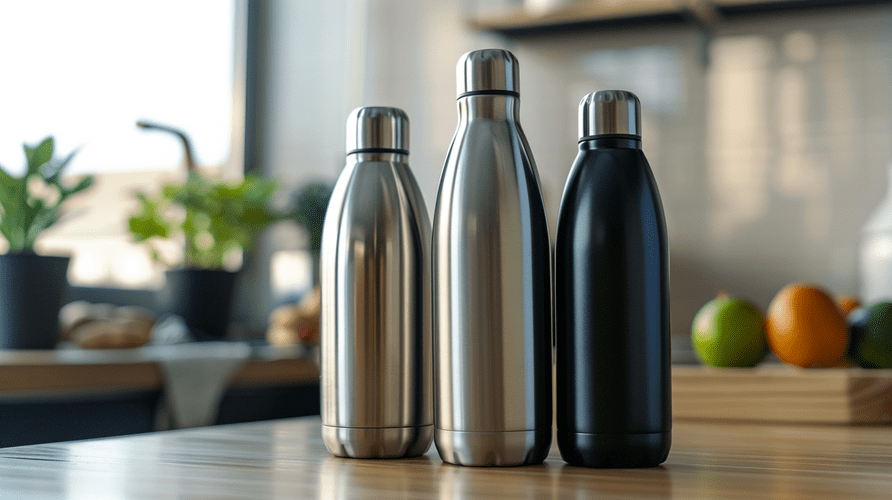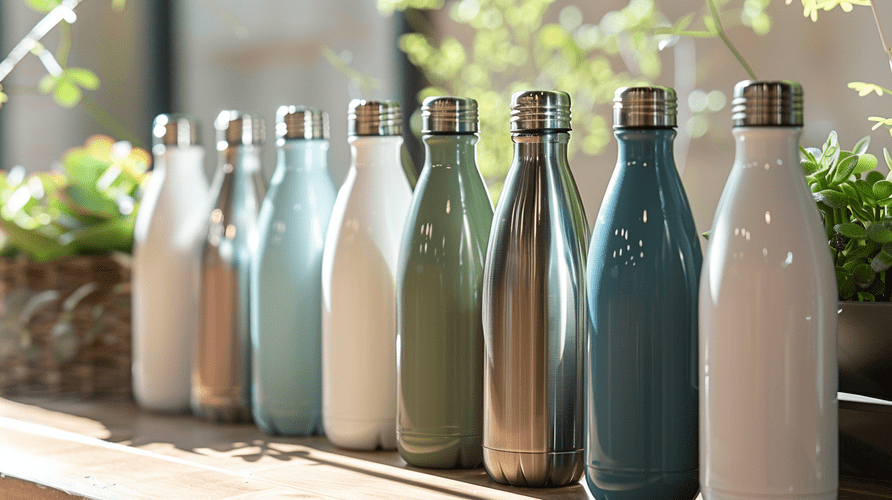Is your insulated bottle failing you? Drinks get warm too fast? Test its performance easily to know for sure.
Fill the bottle with boiling water or ice water. Seal it tight. Check the temperature after set times like 6, 12, or 24 hours. Compare this to what the maker claims. This shows you how it really works day-to-day.

Knowing the basic time test is a good start. But finding a truly great bottle involves more than just watching the clock. Let's dig into how you can really check the quality and performance for your business needs.
How do you test the quality of a water bottle?
Worried your bottles might leak or break easily? Poor quality costs time and money? Simple checks can reveal the bottle's true build quality.
Check for leaks by filling, closing, and shaking it upside down. Look closely at seams and welds for flaws. Make sure the cap seals perfectly. Check for any rust inside. And always test the insulation performance we talked about earlier.

Okay, let's break down "quality" from a buyer's perspective, like my friend Mark Shenng would appreciate. It’s not just about looks when you're buying wholesale. As a procurement officer or business owner, you need reliability.
Material Matters
First, what's it made of? For food contact, you absolutely want food-grade stainless steel. The best and most common choice is 18/8 stainless steel1, also known as Grade 304. Why? It resists rust very well and doesn't leave a strange metallic taste in the water. Sometimes, cheaper bottles use lower-grade steel. This can lead to rust spots over time or affect the drink's flavor. Always ask your supplier, like us at Icobottle, for the exact material specifications. Don't just assume it's good quality.
Construction Counts
Next, how is the bottle put together? The magic of insulation comes from the vacuum seal between the inner and outer walls. If that seal isn't perfect, the insulation won't work well. Look at the welds – are they smooth and clean? Rough spots or gaps can be weak points. The lid is also super important. Does it screw on easily and feel secure? Check the gasket – that little rubbery ring inside the lid. It needs to be intact and create a tight seal. A bad seal means leaks, and it also lets heat escape or enter faster.
Safety and Certification
Is it safe for your customers? Make sure any plastic parts, especially in the lid, are BPA-free2. Reputable suppliers should readily provide safety certifications. For markets like America and Europe, common ones are FDA (for the US) and LFGB (for Europe). These prove the materials are tested and safe for contact with food and drinks. Mark always insists on seeing these certificates. He knows that certificate fraud can happen, so verifying them is a key step to avoid problems later.
Here's a quick table summarizing these quality checks:
| Quality Aspect | Check Method | What to Look For | Why It Matters for B2B |
|---|---|---|---|
| Material Grade | Ask supplier, check spec sheet | 18/8 (304) Stainless Steel | Durability, taste, safety compliance |
| Vacuum Seal | Insulation Test (Hot/Cold) | Maintains temperature well | Core product function |
| Welds/Seams | Visual Inspection | Smooth, no gaps or rough spots | Durability, potential leak points |
| Lid Fit & Seal | Screw on/off, Leak Test | Smooth action, tight seal, no leaks | Prevents spills, maintains temp |
| Safety Certs | Check specs, ask for certs | BPA-free plastics, relevant certs | Market access, legal compliance |
| Overall Finish | Visual Inspection | No rust, dents, or major scratches | Customer perception, brand image |
Checking these points helps ensure the bottles you source will meet your customers' expectations and reflect well on your brand.
How do you check your hot water bottle?
Need your coffee to stay hot for hours? Frustrated by lukewarm drinks mid-morning? A specific test confirms heat retention3 reliably.
First, pre-heat the bottle. Fill it with boiling water, let it sit a minute, then empty it. Refill with your actual boiling drink and seal it fast. Use a thermometer to check the temperature after 1, 3, 6, and maybe 12 hours.

Let's get specific about keeping things hot. This is especially critical for the coffee mugs and tumblers we manufacture and supply at Icobottle. Customers expect their morning coffee or tea to stay hot for a reasonable time. Simply filling the bottle and hoping for the best isn't enough for a thorough check, especially when evaluating suppliers or doing quality control on a batch.
Why Pre-heating Works
I mentioned pre-heating4, and it's important. Think about it: you pour piping hot liquid into a room-temperature metal bottle. The colder inner wall immediately absorbs some of that heat, cooling your drink down slightly right from the start. By filling it with boiling water for a minute first, you warm up that inner steel wall. Then, when you pour out the pre-heat water and add your actual hot beverage, less heat is instantly lost to the bottle itself. It's a small step, but it makes a noticeable difference in maintaining temperature over time.
Factors Influencing Heat Loss
Several things affect how long a bottle stays hot:
- Starting Temperature: Boiling water (100°C / 212°F) will naturally stay hotter for longer than water that's just very hot from the tap (maybe 60°C / 140°F). Always start with the hottest possible liquid for testing heat retention limits.
- Volume: A completely full bottle generally stays hot longer than one that's only half-full. More liquid holds more thermal energy, and less air space inside means less heat can transfer through convection within the bottle.
- Ambient Temperature: Where are you testing? A bottle will lose heat faster sitting on a cold concrete floor in winter than on a desk in a heated office. For consistent results when comparing bottles or batches, try to test in the same temperature environment each time.
- Lid Type: This is a big one often overlooked. A fully sealed, screw-on cap usually provides the best insulation. Lids with flip-tops, sliders, or straw openings inevitably have more seams and potential gaps where heat can escape. Consider how the end-user will use the bottle when evaluating lid performance.
For reliable B2B testing, control these variables. Use the same starting temperature, fill volume, and test in a similar room temperature each time. Record the temperature drop over time.
Here’s a sample way to log your hot water test:
| Time After Filling | Target Temp (Example) | Actual Temp Reading | Test Conditions Notes |
|---|---|---|---|
| 1 Hour | > 85°C (185°F) | Pre-heated, full, sealed lid | |
| 3 Hours | > 75°C (167°F) | Ambient temp approx 20°C (68°F) | |
| 6 Hours | > 65°C (149°F) | Bottle remained closed until check | |
| 12 Hours | > 50°C (122°F) | Still acceptably warm? |
This systematic approach gives you solid data on heat retention performance.
Which brand of water bottle is the best?
Feeling lost choosing between so many bottle brands? Afraid of picking one that disappoints your customers? Focus on finding the right partner, not just a name.
The "best" brand really depends on your specific business needs. Look for suppliers known for quality (18/8 steel), proven insulation, and necessary certifications. For B2B, reliability, customization, and good communication are just as important as the brand name itself.

This question – "Which brand is best?" – comes up a lot, but from my perspective as a manufacturer (Aries Hua from Icobottle) dealing with wholesale buyers like Mark Shenng, it's slightly missing the point for B2B. Often, our customers aren't just reselling an existing brand; they're putting their own brand on the bottles. So, the real question isn't about the best consumer brand, but about finding the best manufacturing partner or supplier for your specific business requirements.
What Defines the "Best" Supplier for B2B?
It’s a combination of factors that go beyond just the physical product.
- Product Quality and Consistency5: Can the supplier reliably produce bottles that meet the quality standards we discussed (material, construction, insulation) every single time you order? Consistency is key for your brand reputation.
- Customization Capabilities6: Can they easily add your logo using different methods (printing, laser engraving)? Can they match your specific brand colors (Pantone matching)? Do they offer packaging options that fit your needs? For rebranding, these capabilities are essential.
- Certifications and Compliance: This is non-negotiable. Do they possess, and can they provide valid proof of, the certifications required for your target markets (e.g., FDA, LFGB, Prop 65)? This avoids costly import problems and ensures product safety. Mark learned the hard way about suppliers faking certificates.
- Communication and Responsiveness: How easy are they to work with? Do their sales reps understand your needs and respond clearly and promptly? Poor communication, as Mark experienced, leads to delays, errors, and immense frustration.
- Reliability and Lead Times: Can they manufacture and ship your orders on schedule? Late shipments can cause you to miss peak selling seasons or important client deadlines. You need a partner who respects timelines.
- Pricing and Minimum Order Quantity (MOQ): Does their wholesale pricing structure allow for your target profit margin? Is their MOQ suitable for your business size and inventory management strategy?
How to Evaluate Potential Suppliers
Finding the right partner takes some homework.
- Request Samples: Get physical samples. Don't rely only on pictures. Test them thoroughly using the insulation and quality checks we've covered.
- Verify Certifications: Ask for copies of all relevant test reports and certifications. If possible, check their validity with the issuing body.
- Inquire About Quality Control (QC): Ask them to explain their QC process during production. What checks do they perform?
- Assess Communication: Send detailed inquiries. See how quickly, clearly, and professionally they respond. Maybe schedule a call.
- Discuss Logistics and Payment: Understand their shipping options, terms (FOB, CIF, etc.), and preferred payment methods. Make sure these align with your capabilities.
- (Optional) Factory Audit: For larger commitments, consider visiting the factory or hiring a third-party service to conduct an audit. This gives deep insight into their operations and working conditions.
Here’s a table to help evaluate potential suppliers:
| Evaluation Factor | Key Question(s) for Supplier | Why It Matters for Your Business |
|---|---|---|
| Product Quality | Can I get samples? What steel grade? QC process? | Reputation, customer satisfaction, returns |
| Customization Options | What logo/color options? Packaging? | Branding effectiveness, market appeal |
| Certifications | Do you have FDA/LFGB/etc.? Can I see them? | Market access, legal safety, risk reduction |
| Communication | Who is my contact? How fast are replies? | Efficiency, error prevention, relationship |
| Lead Time / Reliability | What is production time? On-time record? | Inventory planning, meeting demand |
| Pricing / MOQ | What is unit price per volume? MOQ? | Profitability, cash flow, scalability |
| Logistics / Payment | Shipping terms? Payment methods accepted? | Smooth operations, financial planning |
Choosing a supplier is building a partnership. Look for quality, reliability, and good communication – that’s the foundation for success in this business.
Conclusion
Testing insulation, checking overall quality, and vetting suppliers carefully helps you source reliable bottles that keep drinks perfect and customers happy.
-
Understanding 18/8 stainless steel helps you choose durable, safe water bottles that won't affect taste or rust over time. ↩
-
Learn why BPA-free materials are crucial for health and safety in water bottles, ensuring safe drinking for consumers. ↩
-
Understanding heat retention methods can help you choose the best containers for your beverages, ensuring they stay hot longer. ↩
-
Exploring the importance of pre-heating can enhance your knowledge of thermal efficiency, improving your beverage experience. ↩
-
Exploring this topic will highlight the significance of maintaining high standards for your brand's reputation. ↩
-
Learning about customization capabilities can enhance your branding strategy and product appeal. ↩

